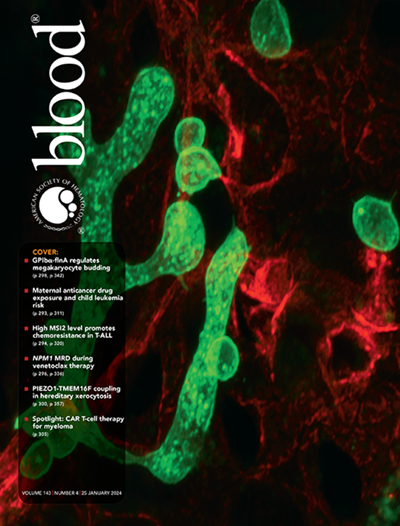Novel, potent, and orally bioavailable LSD1 inhibitors induce fetal hemoglobin synthesis in a sickle cell disease mouse model.
IF 21
1区 医学
Q1 HEMATOLOGY
引用次数: 0
Abstract
Small molecules that inhibit LSD1 (lysine-specific demethylase 1, KDM1A) have been shown to induce abundant fetal hemoglobin (HbF) levels in red blood cells both in vitro and in vivo, therefore potentially serving as potent and cost-effective therapeutics to treat the β-globinopathies, sickle cell disease (SCD) and β-thalassaemia major (TM). However, most LSD1 inhibitors (LSD1i) that induce HbF in vivo are covalent and irreversible, which leads to adverse effects. In this study, we utilized structure-aided drug design to develop potent new reversible LSD1i's leading to robust γ-globin expression in vitro. Moreover, in a mouse model of SCD, oral administration of these novel inhibitors lead to significant HbF elevation and alleviation of multiple features of disease pathology that are the usual consequences of SCD. In addition, we discovered that combined treatment of an LSD1i with a BRD4 degrader (BD-9136) represses the induction of RUNX1 and PU.1, thereby rescuing the erythroid to myeloid lineage conversion that accompanies LSD1i in hematopoiesis. The data indicate that this new generation of LSD1i can effectively induce HbF levels, reduce SCD pathologies, and are well-tolerated by oral administration in SCD mice. We anticipate that the combination of these or related binary compounds offer exciting new therapeutic possibilities for treating SCD and TM.新型、有效且可口服的LSD1抑制剂在镰状细胞病小鼠模型中诱导胎儿血红蛋白合成。
抑制LSD1(赖氨酸特异性去甲基酶1,KDM1A)的小分子已被证明在体外和体内红细胞中诱导丰富的胎儿血红蛋白(HbF)水平,因此有可能作为治疗β-球蛋白病、镰状细胞病(SCD)和β-地中海贫血(TM)的有效且具有成本效益的治疗方法。然而,大多数在体内诱导HbF的LSD1抑制剂(LSD1i)是共价且不可逆的,这导致了不良反应。在这项研究中,我们利用结构辅助药物设计来开发有效的新的可逆LSD1i,导致体外稳健的γ-珠蛋白表达。此外,在SCD小鼠模型中,口服这些新型抑制剂可导致HbF显著升高,并减轻SCD常见后果的多种疾病病理特征。此外,我们发现LSD1i与BRD4降解剂(BD-9136)联合治疗可抑制RUNX1和PU.1的诱导,从而挽救LSD1i在造血过程中伴随的红细胞到髓系的转化。这些数据表明,这种新一代LSD1i可以有效诱导HbF水平,减少SCD病理,并且在SCD小鼠中口服耐受良好。我们预计,这些或相关的二元化合物的组合为治疗SCD和TM提供了令人兴奋的新的治疗可能性。
本文章由计算机程序翻译,如有差异,请以英文原文为准。
求助全文
约1分钟内获得全文
求助全文
来源期刊

Blood
医学-血液学
CiteScore
23.60
自引率
3.90%
发文量
955
审稿时长
1 months
期刊介绍:
Blood, the official journal of the American Society of Hematology, published online and in print, provides an international forum for the publication of original articles describing basic laboratory, translational, and clinical investigations in hematology. Primary research articles will be published under the following scientific categories: Clinical Trials and Observations; Gene Therapy; Hematopoiesis and Stem Cells; Immunobiology and Immunotherapy scope; Myeloid Neoplasia; Lymphoid Neoplasia; Phagocytes, Granulocytes and Myelopoiesis; Platelets and Thrombopoiesis; Red Cells, Iron and Erythropoiesis; Thrombosis and Hemostasis; Transfusion Medicine; Transplantation; and Vascular Biology. Papers can be listed under more than one category as appropriate.
 求助内容:
求助内容: 应助结果提醒方式:
应助结果提醒方式:


